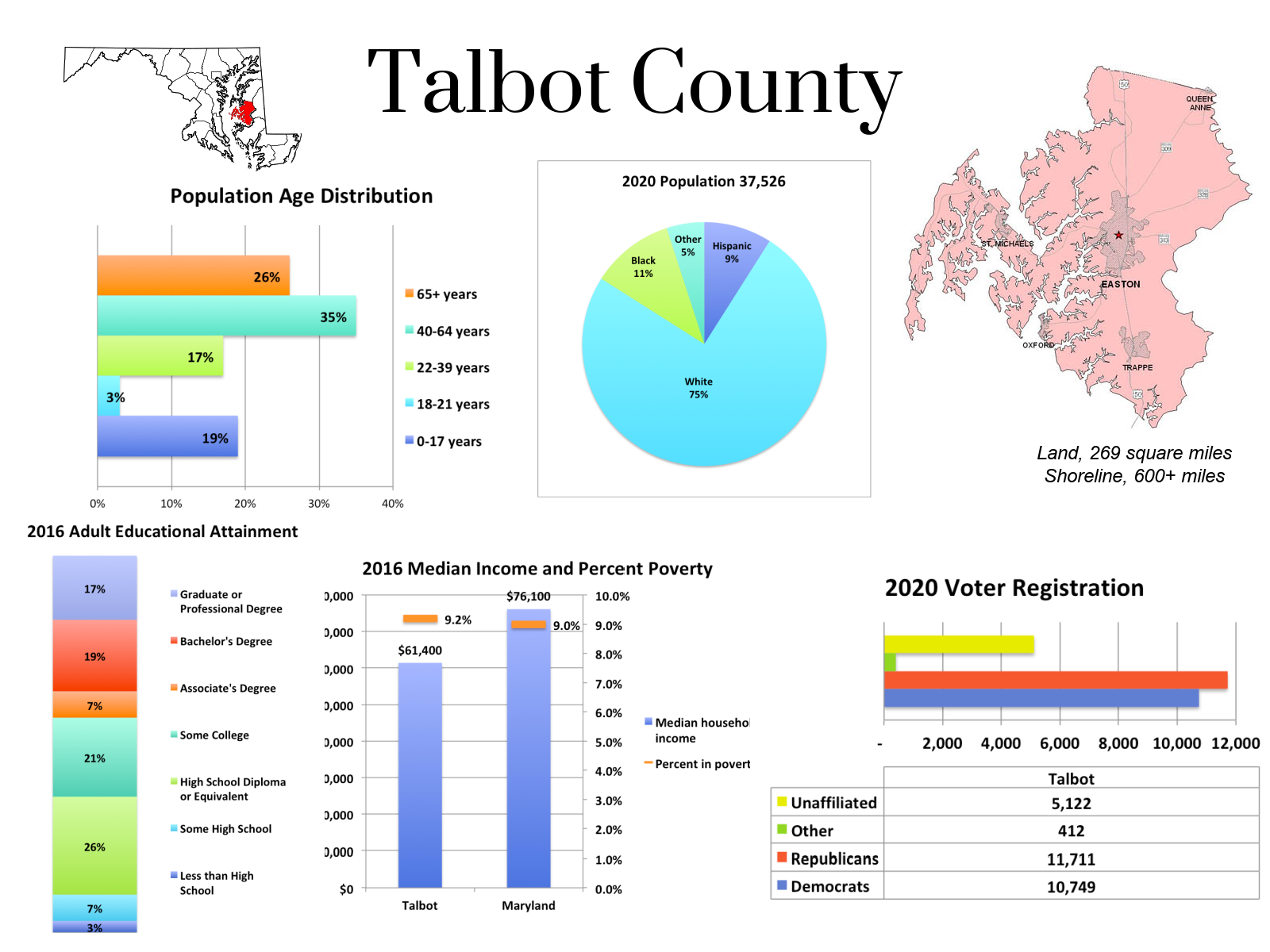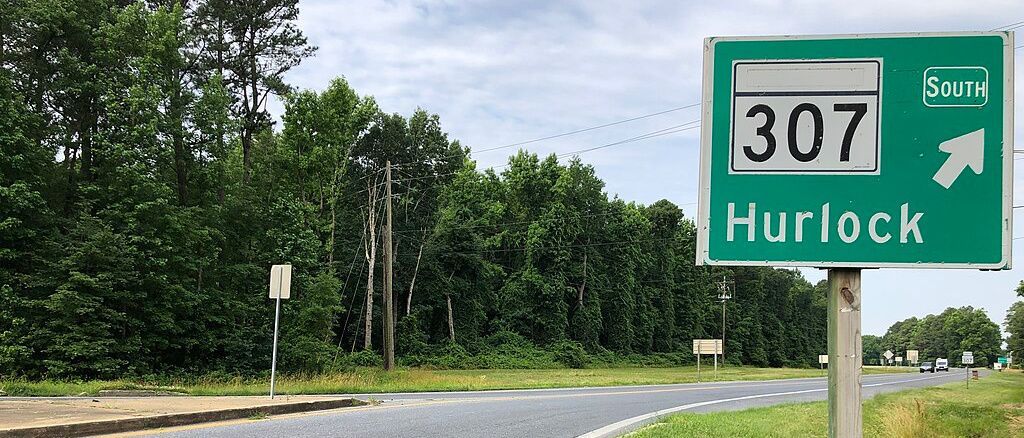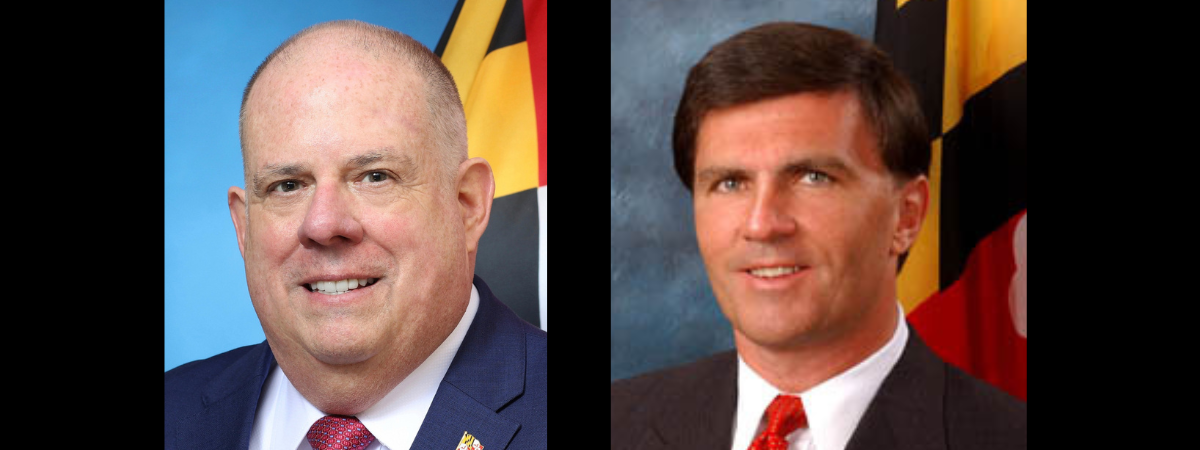Talbot County Profile


Quick Facts:
Talbot County is on the mid-Shore and is the third smallest county in Maryland. Four Shore counties have a larger population than Talbot, and four have a smaller population. Talbot has a population density of 140 people per square mile.
- Land area is 269 square miles
- Water area is 208 square miles (44% of total area)
Less than 20% of agricultural, forested, and important natural and water resource lands are preserved — Talbot and Wicomico are tied for last place in this category. Only 9% of agricultural and resource lands are under threat of development inconsistent with state goals for land and resource conservation.
A current land use battle involves the Lakeside Development project in Trappe. Previous planning decisions approved a massive housing and commercial project that includes 2,500 homes, despite serious concerns about planned sewage disposal and the scale of growth in a rural area. Protests are ongoing.
Elsewhere in the county, the Paul S. Sarbanes Ecosystem Restoration Project at Poplar Island is restoring this island habitat in the mid-Chesapeake Bay. The island-building project uses dredged material from the Baltimore shipping channel. Almost 375 acres of wetland habitat have been constructed so far, attracting 250 species of birds and a thriving Diamond Terrapin population.
Talbot’s most famous native son is Frederick Douglass, born into slavery in 1817 or 1818. After escaping, he became famous as a social reformer, abolitionist, orator, writer, and statesman.
The Talbot County courthouse has been home to monumental controversies in the 21st Century. A statue honoring Douglass was approved in 2004 by the Talbot County Council, with a one-vote majority, after overcoming opposition by local veterans; a compromise was reached that specified the Douglass monument would be no taller than the adjacent Talbot Boys statue.
By 2021, the Talbot Boys statue was the only remaining Confederate statue on public grounds in the state of Maryland. After years of debate and legal and political action, the County Council finally voted 3-2 to remove the statue, which was moved to a private battlefield in Virginia in 2022.
Talbot County’s population breakdown by race and ethnicity:
- 75% White, non-Hispanic
- 11% Black, non-Hispanic
- 9% Hispanic
- 5% Other, non-Hispanic
Talbot County closely mirrors the state as a whole in educational achievement:

Talbot County has the third highest median income on the Shore — $61,400 — and the second lowest poverty level (9.2%).
In the second quarter of 2020, Talbot County had the second highest home value on the Eastern Shore, almost $380,000, second only to Queen Anne’s. Despite this high value, only 29% of homeowners paid more than 35% of their income on housing costs, compared with 52% of renters. A full 8.5% of county residents don’t have health insurance (tied for highest with Somerset), compared with 6.9% statewide.
In November 2022, Talbot County’s unemployment rate (not seasonally adjusted) was 3.7%. Maryland’s was 3.5%. Six counties on the Shore had unemployment rates below 4% that month.
Talbot County is trending Democratic politically. In 2020, Joe Biden became the first Democratic candidate to carry Talbot since Lyndon B. Johnson in 1964.
Republicans hold an edge of 42% to 38% in voter registrations, but in 2022, Democrats Wes Moore and Aruna Miller (candidates for governor and lieutenant governor) carried the county with 52% of the vote; Chris Van Hollen (candidate for U.S. Senate) won 51% of the vote; and Heather Mizeur (candidate for U.S. Congress) beat the incumbent, Andrew P. Harris, 52% to 46%. Anthony Brown (candidate for Maryland attorney general) lost to his Republican opponent by only 8 votes in Talbot.
The Oxford-Bellevue Ferry is one of four remaining river ferries in Maryland. It is the oldest privately owned ferry in the U.S., established in 1683, and crosses the Tred Avon River. The ferry has a long history of women owners and captains. Eighteen Mini Coopers can fit on the nine-car ferry.
Sources:
U.S. Census Bureau, 2020 Decennial Census, Hispanic and Not Hispanic by Race
Statistical Atlas, Maryland
https://statisticalatlas.com/state/Maryland
Maryland Department of Planning Data Center, Sustainability Indicators
https://planning.maryland.gov/MSDC/Pages/sustainability_indicator/sustainabilityindicator.aspx
Maryland State Board of Elections, Official 2022 Gubernatorial Election Results
https://www.elections.maryland.gov/elections/2022/general_results/index.html
Maryland State Board of Elections, Eligible Active Voters, 2020 Presidential Election
Maryland Department of Labor, Local Area Unemployment Statistics
https://www.dllr.state.md.us/lmi/laus/
Wikipedia, Talbot County, Md.
https://en.wikipedia.org/wiki/Talbot_County,_Maryland
Poplar Island
http://www.poplarislandrestoration.com/
Oxford-Bellevue Ferry
Wikipedia, Frederick Douglass
https://en.wikipedia.org/wiki/Frederick_Douglass
Jan Plotczyk spent 25 years as a survey and education statistician with the federal government, at the Census Bureau and the National Center for Education Statistics. She retired to Rock Hall.
Common Sense for the Eastern Shore







